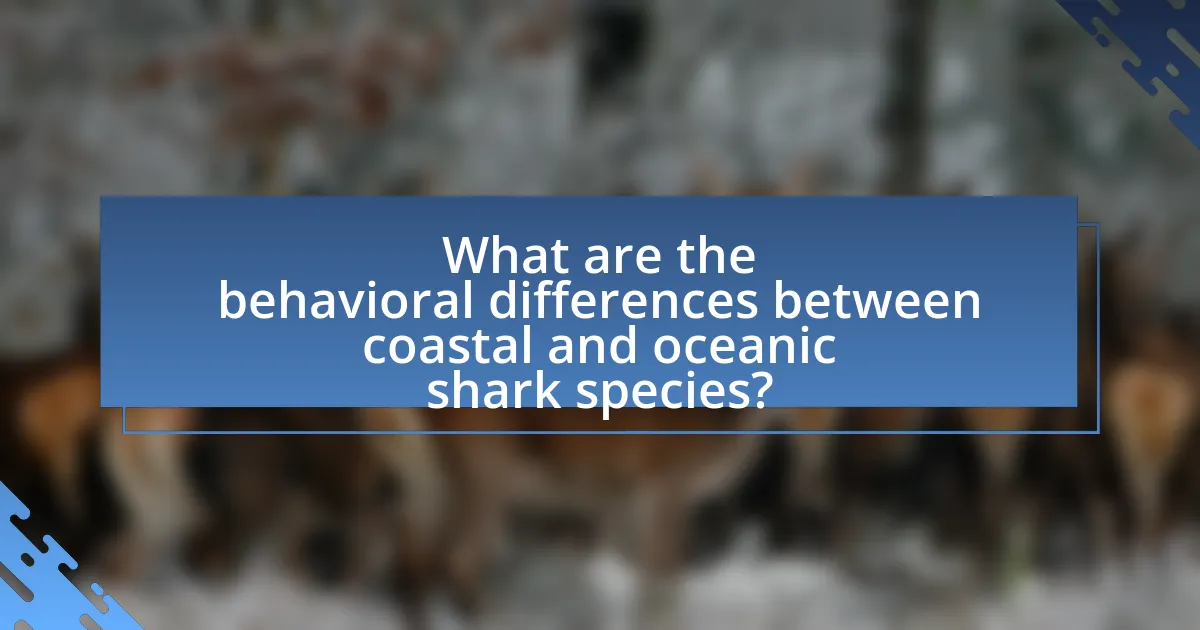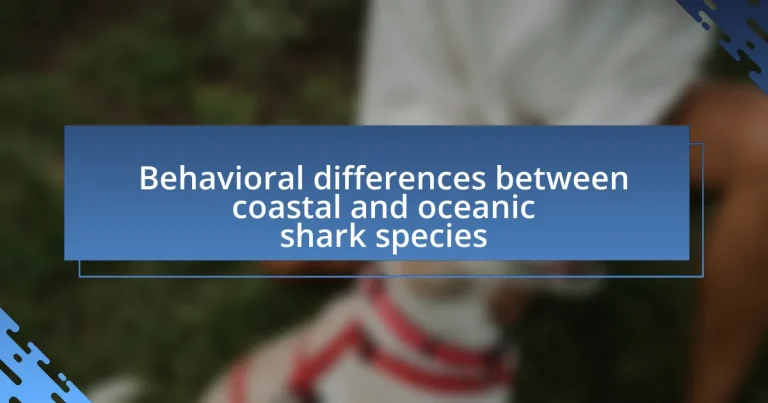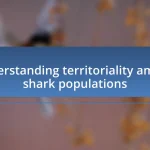The article examines the behavioral differences between coastal and oceanic shark species, highlighting how their habitats influence their feeding, mating, and social interactions. Coastal sharks, such as the blacktip reef shark, exhibit social behaviors and utilize shallow waters for hunting and breeding, while oceanic sharks, like the great white shark, are more solitary and migrate over vast distances in search of prey. The article also discusses how environmental factors, human activities, and specific conservation strategies impact these species, emphasizing the need for tailored management approaches to ensure their survival. Understanding these behavioral distinctions is crucial for effective conservation efforts aimed at protecting both coastal and oceanic shark populations.

What are the behavioral differences between coastal and oceanic shark species?
Coastal shark species exhibit behaviors that are often influenced by their proximity to shorelines, such as hunting in shallow waters and forming schools, while oceanic shark species tend to be solitary and migrate over vast distances in open waters. Coastal sharks, like the blacktip reef shark, often engage in nursery behaviors, utilizing estuaries for breeding, whereas oceanic species, such as the great white shark, display migratory patterns that can span thousands of miles, driven by prey availability and water temperature. These behavioral distinctions are supported by studies indicating that coastal sharks adapt to dynamic environments with varying salinity and habitat structures, while oceanic sharks are adapted to stable, deep-water conditions, highlighting their differing ecological roles and survival strategies.
How do habitat preferences influence shark behavior?
Habitat preferences significantly influence shark behavior by dictating their feeding, mating, and social interactions. Coastal sharks, such as the blacktip reef shark, often exhibit behaviors that are adapted to shallow waters, including hunting in schools and utilizing the structure of reefs for ambush predation. In contrast, oceanic sharks, like the great white shark, display solitary behaviors and are adapted for open-water hunting, often covering vast distances in search of prey. Research indicates that these behavioral adaptations are closely linked to the availability of prey and environmental conditions specific to their habitats, such as temperature and salinity, which further shape their foraging strategies and reproductive patterns.
What specific habitats do coastal sharks prefer?
Coastal sharks prefer habitats such as shallow waters, estuaries, and coral reefs. These environments provide abundant food sources and shelter, which are essential for their survival and reproduction. Research indicates that species like the blacktip reef shark and the bull shark are commonly found in these areas, utilizing the rich biodiversity and structure of coastal ecosystems for hunting and breeding.
How do oceanic sharks adapt to their open-water environments?
Oceanic sharks adapt to their open-water environments through specialized physiological and behavioral traits. These adaptations include streamlined bodies that reduce drag while swimming, enabling efficient movement across vast distances. Additionally, oceanic sharks possess a highly developed sense of smell and electroreception, allowing them to detect prey from great distances in the open ocean. Their ability to regulate buoyancy through a large oil-filled liver helps them maintain depth without expending excessive energy. Furthermore, many oceanic species exhibit migratory behaviors, traveling thousands of miles to find food and breeding grounds, which is essential for survival in the expansive and often nutrient-scarce open waters.
What role does feeding behavior play in differentiating these species?
Feeding behavior plays a crucial role in differentiating coastal and oceanic shark species by influencing their dietary preferences and hunting strategies. Coastal sharks, such as the bull shark, often exhibit opportunistic feeding habits, targeting a variety of prey including fish, crustaceans, and even birds, which are abundant in shallow waters. In contrast, oceanic sharks, like the great white shark, primarily hunt larger marine mammals and pelagic fish, utilizing deep-water hunting techniques and often engaging in ambush strategies. This distinction in feeding behavior is supported by studies showing that coastal species adapt to diverse prey availability in their environments, while oceanic species have evolved specialized adaptations for hunting in open waters, such as enhanced speed and sensory capabilities.
What are the primary feeding strategies of coastal sharks?
Coastal sharks primarily employ ambush predation and scavenging as their feeding strategies. Ambush predation involves stealthily approaching prey, often using the element of surprise to capture fish and invertebrates that inhabit shallow waters. Scavenging, on the other hand, allows coastal sharks to feed on carrion or leftovers from larger predators, which is particularly common in nutrient-rich coastal environments. Research indicates that species such as the blacktip reef shark and the bull shark exhibit these strategies effectively, adapting their feeding behavior based on prey availability and environmental conditions.
How do oceanic sharks hunt in the vast ocean?
Oceanic sharks hunt in the vast ocean primarily through a combination of speed, stealth, and sensory adaptations. These sharks utilize their acute sense of smell to detect prey from great distances, often tracking the scent of blood in the water. They also rely on their excellent vision and the ability to sense electrical fields generated by other marine animals, which aids in locating prey even in murky waters.
For instance, species like the great white shark can swim at speeds up to 25 miles per hour, allowing them to ambush prey effectively. Additionally, oceanic sharks often employ a hunting strategy known as “breaching,” where they launch themselves out of the water to surprise seals or fish. This method is particularly effective in open ocean environments where prey may be less vigilant.
Research indicates that the hunting behavior of oceanic sharks is influenced by their need to cover large distances in search of food, contrasting with coastal sharks that may rely on more localized hunting strategies.
How do social behaviors differ between coastal and oceanic sharks?
Coastal sharks exhibit more social behaviors compared to oceanic sharks, often forming schools or aggregations, particularly during feeding or mating. In contrast, oceanic sharks tend to be more solitary, with species like the great white and tiger shark displaying less social interaction and often roaming vast distances alone. Research indicates that coastal species, such as the blacktip reef shark, utilize social structures for protection and resource sharing, while oceanic species rely on individual hunting strategies and territoriality, as evidenced by studies observing their behavior in different habitats.
What social structures are observed in coastal shark species?
Coastal shark species exhibit a range of social structures, primarily characterized by solitary behavior, small groups, or aggregations during specific activities such as feeding or mating. For instance, species like the blacktip reef shark often form schools, particularly in nursery areas, which can enhance protection against predators and increase foraging efficiency. Research indicates that these social structures can vary significantly among species and are influenced by environmental factors, such as habitat availability and prey density. Studies have shown that social interactions among coastal sharks can lead to increased reproductive success and improved survival rates, highlighting the adaptive significance of these social behaviors.
How do oceanic sharks interact with each other in their environment?
Oceanic sharks interact with each other primarily through social behaviors such as schooling, territoriality, and communication via body language and vocalizations. Species like the hammerhead shark exhibit schooling behavior, which can enhance foraging efficiency and provide protection against predators. Additionally, oceanic sharks often establish territories and engage in displays of dominance or aggression to maintain their space, particularly during mating seasons. Research indicates that these interactions are crucial for their survival and reproductive success, as evidenced by studies showing that social structures can influence feeding strategies and mating opportunities among species like the great white shark and the tiger shark.

What factors contribute to the behavioral differences in sharks?
Behavioral differences in sharks are primarily influenced by environmental factors, prey availability, and social structures. Coastal sharks, such as the blacktip reef shark, often exhibit behaviors adapted to shallow waters, including hunting in groups and utilizing complex habitats like reefs. In contrast, oceanic sharks, like the great white shark, display solitary behaviors and are adapted to open ocean environments, where they rely on different hunting strategies and migratory patterns. Research indicates that these behavioral adaptations are crucial for survival, as they allow sharks to optimize feeding efficiency and reproductive success in their respective habitats. For instance, studies have shown that the presence of prey species and habitat complexity significantly affect the foraging behavior of coastal sharks, while oceanic species are more influenced by migratory routes and ocean currents.
How does environmental variability affect shark behavior?
Environmental variability significantly influences shark behavior by altering their feeding patterns, migration routes, and reproductive activities. For instance, changes in water temperature can affect prey availability, prompting sharks to adjust their hunting strategies. Research indicates that species like the great white shark exhibit altered movement patterns in response to shifts in oceanographic conditions, such as temperature and salinity, which impact their prey distribution. Additionally, environmental factors like seasonal changes and habitat degradation can lead to shifts in reproductive timing and location, as seen in species such as the blacktip reef shark, which adjusts its breeding behavior based on water temperature fluctuations. These behavioral adaptations are crucial for survival, as they enable sharks to optimize their foraging efficiency and reproductive success in varying environmental conditions.
What environmental factors are most influential for coastal sharks?
Coastal sharks are most influenced by water temperature, salinity, and habitat availability. These environmental factors directly affect their distribution, feeding behavior, and reproductive patterns. For instance, water temperature influences metabolic rates and breeding cycles, with many coastal shark species preferring warmer waters for reproduction. Salinity levels impact their physiological adaptations, as many coastal sharks inhabit brackish waters where freshwater meets the ocean. Additionally, the availability of habitats such as reefs, estuaries, and mangroves provides essential resources for feeding and nursery grounds, which are critical for the survival of juvenile sharks. Studies have shown that changes in these environmental factors can lead to shifts in shark populations and behaviors, highlighting their significance in the ecology of coastal ecosystems.
How do oceanic sharks respond to changes in ocean conditions?
Oceanic sharks exhibit various behavioral adaptations in response to changes in ocean conditions, such as temperature fluctuations, salinity variations, and shifts in prey availability. These sharks often migrate to maintain optimal thermal conditions, as evidenced by studies showing that species like the great white shark can travel thousands of kilometers to find suitable habitats. Additionally, oceanic sharks may alter their feeding patterns in response to changes in prey distribution, which is influenced by oceanographic factors. Research indicates that changes in ocean currents can lead to significant shifts in the abundance and location of prey species, prompting oceanic sharks to adjust their foraging strategies accordingly.
What impact does human activity have on shark behavior?
Human activity significantly alters shark behavior, primarily through overfishing, habitat destruction, and pollution. Overfishing reduces prey availability, leading sharks to adapt their hunting strategies or migrate to new areas. Habitat destruction, such as coastal development and mangrove deforestation, disrupts breeding and nursery grounds, forcing sharks to change their movement patterns. Pollution, including plastic waste and chemical runoff, can affect shark health and behavior, as they may avoid contaminated areas or experience altered reproductive success. Studies have shown that these factors contribute to shifts in shark populations and their ecological roles, highlighting the profound impact of human actions on their behavior.
How does fishing pressure affect coastal shark populations?
Fishing pressure significantly reduces coastal shark populations by increasing mortality rates and disrupting reproductive cycles. Overfishing, particularly through methods like gillnetting and longlining, leads to a decline in shark numbers, which can result in population imbalances and decreased genetic diversity. Studies indicate that regions with high fishing pressure can experience up to a 90% decline in certain shark species, such as the blacktip reef shark, affecting their role in the ecosystem as apex predators. This decline not only impacts the sharks themselves but also the overall health of coastal marine environments, as sharks play a crucial role in maintaining the balance of marine life.
What are the effects of pollution on oceanic shark behavior?
Pollution significantly alters oceanic shark behavior by affecting their sensory perception, foraging patterns, and reproductive success. Studies indicate that chemical pollutants, such as heavy metals and microplastics, can impair sharks’ olfactory senses, which are crucial for locating prey and navigating their environment. For instance, research published in the journal “Marine Ecology Progress Series” found that exposure to pollutants can lead to decreased hunting efficiency in species like the great white shark, as their ability to detect prey odors is compromised. Additionally, pollutants can disrupt hormonal systems, impacting reproductive behaviors and leading to lower reproductive rates. This evidence highlights the detrimental effects of pollution on the behavioral ecology of oceanic sharks.

What are the implications of these behavioral differences for conservation efforts?
Behavioral differences between coastal and oceanic shark species significantly impact conservation efforts by necessitating tailored management strategies. Coastal sharks often exhibit site fidelity and are more vulnerable to habitat degradation, making localized conservation measures essential. In contrast, oceanic sharks, which are highly migratory, require broader, international conservation frameworks to address their extensive range and the threats they face from fishing practices. For instance, the International Union for Conservation of Nature (IUCN) emphasizes that understanding these behavioral patterns is crucial for developing effective conservation policies, as different species may respond uniquely to environmental changes and human activities.
How can understanding shark behavior aid in conservation strategies?
Understanding shark behavior is crucial for developing effective conservation strategies, as it allows researchers to identify critical habitats and migration patterns. For instance, studies have shown that coastal shark species often exhibit distinct behaviors such as nursery site fidelity, which can inform the establishment of protected areas. Additionally, knowledge of oceanic shark species’ migratory routes helps in creating management plans that mitigate threats like overfishing and habitat degradation. Research published in the journal “Marine Ecology Progress Series” by Heupel et al. (2010) highlights that understanding these behavioral patterns directly contributes to the preservation of shark populations and the ecosystems they inhabit.
What specific conservation measures are effective for coastal sharks?
Effective conservation measures for coastal sharks include the establishment of marine protected areas (MPAs), implementation of sustainable fishing practices, and enforcement of regulations against shark finning. MPAs provide safe habitats where sharks can thrive, as evidenced by studies showing increased shark populations in protected regions. Sustainable fishing practices, such as catch limits and gear modifications, reduce bycatch and ensure that shark populations are not overexploited. Additionally, strict regulations against shark finning have been shown to decrease the mortality rates of sharks, contributing to healthier ecosystems. These measures collectively support the conservation of coastal shark species and their habitats.
How can oceanic shark conservation be improved based on their behavior?
Oceanic shark conservation can be improved by understanding their migratory patterns and social behaviors. Research indicates that oceanic sharks, such as the great white and hammerhead, exhibit specific migratory routes influenced by factors like prey availability and water temperature. By mapping these patterns, conservation efforts can focus on protecting critical habitats and migration corridors. For instance, studies have shown that great white sharks migrate thousands of miles to reach breeding grounds, highlighting the need for international cooperation in marine protected areas. Additionally, understanding their social structures can inform regulations on fishing practices, as certain species are more vulnerable during breeding seasons. Implementing these behavior-based strategies can enhance the effectiveness of conservation initiatives for oceanic sharks.
What best practices can be implemented for shark conservation?
Best practices for shark conservation include establishing marine protected areas (MPAs) to safeguard critical habitats, implementing sustainable fishing practices to reduce bycatch, and enforcing regulations against shark finning. MPAs have been shown to enhance shark populations by providing safe breeding and feeding grounds, as evidenced by studies indicating a 50% increase in shark abundance within protected zones. Sustainable fishing practices, such as using circle hooks and modifying gear, can significantly decrease the accidental capture of sharks, thereby preserving their populations. Additionally, strict enforcement of anti-finning laws is crucial, as the global shark fin trade has led to a dramatic decline in shark numbers, with estimates suggesting that up to 100 million sharks are killed annually for their fins.
How can local communities contribute to the protection of coastal sharks?
Local communities can contribute to the protection of coastal sharks by engaging in conservation efforts, promoting sustainable fishing practices, and participating in educational programs. These actions help reduce overfishing and habitat destruction, which are significant threats to shark populations. For instance, community-led initiatives such as marine protected areas have been shown to increase shark abundance and biodiversity, as evidenced by studies indicating that protected regions can see up to a 50% increase in shark populations over time. Additionally, local awareness campaigns can foster a culture of respect for marine life, leading to more responsible behaviors among fishers and tourists alike.
What role do international policies play in oceanic shark conservation?
International policies play a crucial role in oceanic shark conservation by establishing frameworks for sustainable management and protection of shark populations across international waters. These policies, such as the Convention on International Trade in Endangered Species (CITES) and regional fisheries management organizations (RFMOs), regulate fishing practices, limit catch quotas, and promote research on shark species. For instance, CITES has listed several shark species, including the hammerhead and whale shark, under its Appendix II, which requires countries to ensure that trade does not threaten their survival. Additionally, RFMOs implement measures like closed fishing seasons and designated marine protected areas to safeguard critical habitats for oceanic sharks. These international agreements are essential for coordinating conservation efforts among nations, as sharks often migrate across borders, making unilateral national policies insufficient for their protection.


